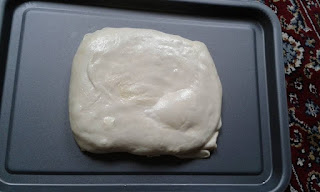 It's hard to describe molokhiya if you've never seen or tasted it. Molokhiya / mulukhiyah / malukhiya etc (sometimes known in English as Jew's mallow) is a Middle Eastern and North African soupy/stew-like dish that uses leaves from the corchorus olitorios plant as a base. The leaves have an unusual texture, mucilaginous or slimy, similar in character to okra. There are a number of different ways to prepare molokhiya, in Tunisia the leaves are dried and ground to a fine powder before being mixed with oil and slow cooked in a stew, in other countries of the Middle East the dried leaves may be used, in Egypt often the fresh leaf is preferred. I've made molokhiya before using the Tunisian method (I brought back 1kg of molokhiya powder when I was last there), but as fresh molokhiya is pretty much impossible to find here Egyptian style is something I have never attempted. However a work colleague who is of Sudanese origin informed me that one of the Asian grocery stores now had little Egyptian /Sudan section, and in addition to stocking the dried leaf, they also had frozen molokhiya! So, what's a person to do? I made a trip there pronto and gathered all the ingredients together to cook up an Alexandrian style molokhiya with prawns! In the rest of Egypt rabbit, or perhaps lamb is the preferred meat, and when I have cooked molokhiya before I used soya chunks. While I am pretty much 99% vegetarian, however, I do on occasion eat fish and prawns, and having found some juicy looking tiger prawns in the supermarket I knew just what to do with them...
It's hard to describe molokhiya if you've never seen or tasted it. Molokhiya / mulukhiyah / malukhiya etc (sometimes known in English as Jew's mallow) is a Middle Eastern and North African soupy/stew-like dish that uses leaves from the corchorus olitorios plant as a base. The leaves have an unusual texture, mucilaginous or slimy, similar in character to okra. There are a number of different ways to prepare molokhiya, in Tunisia the leaves are dried and ground to a fine powder before being mixed with oil and slow cooked in a stew, in other countries of the Middle East the dried leaves may be used, in Egypt often the fresh leaf is preferred. I've made molokhiya before using the Tunisian method (I brought back 1kg of molokhiya powder when I was last there), but as fresh molokhiya is pretty much impossible to find here Egyptian style is something I have never attempted. However a work colleague who is of Sudanese origin informed me that one of the Asian grocery stores now had little Egyptian /Sudan section, and in addition to stocking the dried leaf, they also had frozen molokhiya! So, what's a person to do? I made a trip there pronto and gathered all the ingredients together to cook up an Alexandrian style molokhiya with prawns! In the rest of Egypt rabbit, or perhaps lamb is the preferred meat, and when I have cooked molokhiya before I used soya chunks. While I am pretty much 99% vegetarian, however, I do on occasion eat fish and prawns, and having found some juicy looking tiger prawns in the supermarket I knew just what to do with them...400g bag frozen molokhia
~500ml vegetable stock
Olive oil
1 large onion
4 cloves of garlic
2 tablespoons tomato paste
1 tablespoon harissa
1 tablespoon ground coriander
1 tablespoon ground cumin
1 large bunch of coriander
For takliya
Margarine or butter
1 tsp ground coriander
4 cloves of garlic (crushed)
6-8 large prawns
1. Slice the onions thinly and fry in olive oil with crushed garlic until softened. Stir in the tomato paste, harissa, and spices and cook for a few minutes. Add vegetable stock (around 500ml) and the frozen molokhia. I just put the block in the pan and waited for it to thaw
2. Once it’s melted stir it in, put the lid on and simmer on a very
low heat for around 30 minutes
3. When the molokhia is almost done, make the takliya, which is the garlicky sauce to mix in. Fry crushed garlic and coriander until golden brown, and then stir into the molokhia mixture
4. Stir in the finely chopped coriander, and turn off the heat
5. I reserved a little of the takliya back and then added the prawns to the pan to cook in the garlicky and buttery juices
6. Serve with white rice and lemon slices to squeeze over.
3. When the molokhia is almost done, make the takliya, which is the garlicky sauce to mix in. Fry crushed garlic and coriander until golden brown, and then stir into the molokhia mixture
4. Stir in the finely chopped coriander, and turn off the heat
5. I reserved a little of the takliya back and then added the prawns to the pan to cook in the garlicky and buttery juices
6. Serve with white rice and lemon slices to squeeze over.











